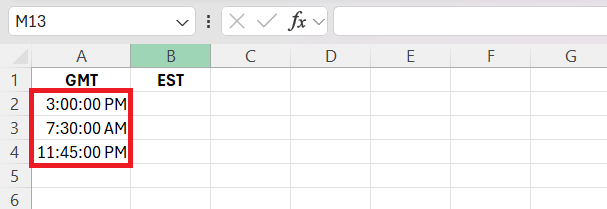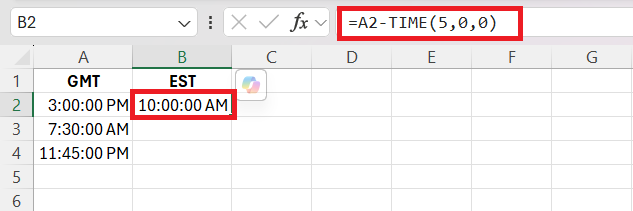Working with global time zones can be tricky, especially when dealing with data across different regions. I often need to convert Greenwich Mean Time (GMT) to Eastern Standard Time (EST) in Excel to keep my schedules and reports accurate. Since EST is either 5 or 4 hours behind GMT, depending on Daylight Saving Time, having the right formulas and tools is essential. In this guide, I’ll walk you through various methods to efficiently handle this conversion.
Key Takeaways:
- Understanding Time Zones – GMT is the global reference, while EST is 5 hours behind, except during Daylight Saving Time (EDT), when it’s 4 hours behind.
- Excel Formulas for Conversion – Use
=A2-TIME(5,0,0)to convert GMT to EST, adjusting for Daylight Saving Time with anIFformula. - Handling Large Datasets – Apply formulas across multiple rows using the fill handle for bulk conversions efficiently.
- Avoiding Common Mistakes – Ensure correct cell formatting, account for DST changes, and verify regional settings in Excel.
- Advanced Time Zone Management – Automate conversions with VBA, use named ranges for clarity, and cross-check results with online time zone tools.
Table of Contents
Introduction to Time Zone Conversions
The Importance of Accurate Time Conversions
Time zone conversions are crucial in today’s interconnected world. Whether scheduling international meetings, tracking global financial markets, or planning online events, getting the timing right is essential. A small miscalculation can lead to missed opportunities, miscommunication, and unnecessary delays. That’s why having a simple and accurate method for converting GMT to EST in Excel is so valuable.
Overview of GMT and EST Time Zones
Greenwich Mean Time (GMT) serves as the primary time reference worldwide. It is the standard time at the Royal Observatory in Greenwich, London, from which all other time zones are derived.
On the other hand, Eastern Standard Time (EST) is used in parts of North America, including the east coast of the United States and Canada. EST is always five hours behind GMT. This means that when it is 12:00 PM (noon) GMT, it is 7:00 AM EST.
Setting Up Your Excel Sheet for Conversion
Understanding Excel’s TIME Function
Excel’s TIME function helps create a valid time value using individual hour, minute, and second components. The syntax is:
=TIME(hour, minute, second)
For example, =TIME(14, 30, 0) represents 2:30 PM. This function ensures accuracy when manipulating time values in Excel, making it easier to perform conversions.
Converting GMT to EST in Excel: Step-by-Step Guide
Converting GMT (Greenwich Mean Time) to EST (Eastern Standard Time) in Excel is a straightforward process once you understand the time difference between these two time zones. EST is 5 hours behind GMT, which means to convert a time from GMT to EST, you need to subtract 5 hours.
Here’s a step-by-step guide on how to perform the conversion in Excel:
STEP 1: Preparing Your Data for Conversion
Before you start the conversion, ensure that your GMT times are correctly entered in Excel. Times should be in a standard format, such as hh:mm:ss AM/PM. You can have a column of times that represent GMT, which will be the starting point for your conversion.
STEP 2: Entering the Correct Formula
Once your data is formatted correctly, you can apply the formula to convert GMT to EST. Since EST is five hours behind GMT, use the following formula in a new column:
=A2-TIME(5,0,0)
Here, A2 represents the cell containing the GMT timestamp.
STEP 3: Applying the Formula to Multiple Rows
After entering the formula, use the fill handle (the small square at the bottom-right corner of the selected cell) to drag the formula down and apply it to all relevant rows. This ensures that each GMT timestamp is accurately converted to EST across your dataset.
Dealing with Daylight Saving Time Adjustments
During Daylight Saving Time (DST), EST transitions to Eastern Daylight Time (EDT), which is only 4 hours behind GMT. To account for this, you can use an IF formula:
=IF(AND(A1>=[DST Start Date],A1<=[DST End Date]), A1-TIME(4,0,0), A1-TIME(5,0,0))
This ensures that the correct time adjustment is applied only during the DST period. Keep a reference table of DST start and end dates for easy lookup. Assume you have a list of GMT times in column A, and you want to convert them to EST or EDT depending on the DST period.
Advanced Tips for Time Zone Calculations in Excel
- Use Named Ranges: Assign a name like
GMT_Timeto your column and reference it in formulas for better readability. - Conditional Formatting: Highlight converted times in a different color to distinguish them easily.
- Use UTC Instead of GMT: If working with timestamps from different regions, using Coordinated Universal Time (UTC) might be more precise.
- Automate with VBA: For repetitive conversions, create a VBA macro to automate the process.
- Cross-Check Time Zones: Use online world clocks or time zone converters to validate Excel results.
- Account for Different Regions: If collaborating with global teams, consider additional time zones beyond EST.
- Incorrect Cell Formatting: Ensure all timestamps are in ‘Time’ or ‘Date & Time’ format to avoid errors.
- Overlooking DST Adjustments: Always check whether your data falls within the DST period and adjust formulas accordingly.
- Regional Settings Mismatch: Different Excel versions and computer settings can affect how dates and times are interpreted. Double-check your locale settings.
By following these steps, you can seamlessly convert GMT to EST in Excel while avoiding common pitfalls. Excel makes time zone conversions easy and efficient, especially when working with large datasets!
FAQs on GMT to EST Conversion in Excel
How do you convert GMT to EST?
To convert GMT to EST in Excel, you simply subtract five hours using the formula =A1-TIME(5,0,0) where A1 is the cell with the GMT time. Drag the formula down the column to apply it to all relevant cells. Make sure to adjust for Daylight Saving Time when in effect by subtracting four hours instead.
How Do You Automatically Account for Daylight Savings Changes?
To automatically account for Daylight Saving Time changes in Excel, you insert a conditional formula that checks whether the date falls within the DST period. If it does, adjust the conversion by one hour less. For instance: =IF(AND(A1>=[DST Start],A1<=[DST End]), A1-TIME(4,0,0), A1-TIME(5,0,0)). Remember to replace [DST Start] and [DST End] with the actual start and end dates of DST.
Can You Convert Multiple Time Zones at Once in Excel?
Yes, in Excel, you can convert multiple time zones at once by applying the same conversion formula across multiple cells. Simply enter the appropriate formula for each time zone conversion in one cell and drag it across to other cells. Excel will replicate the formula while adjusting the cell references accordingly. For more complex conversions involving different rules, consider using conditional formulas or creating a macro.
How to convert GMT to IST time in Excel?
To convert GMT to Indian Standard Time (IST) in Excel, add 5 hours and 30 minutes as IST is ahead of GMT by that duration. Use the formula =A1+TIME(5,30,0) where A1 is the cell containing the GMT time. Drag the fill handle to apply it to the entire column. This accounts for the time difference effectively converting GMT to IST.
How do you convert time to EST in Excel?
To convert time to Eastern Standard Time (EST) in Excel, subtract 5 hours from the original time using the formula =A1-TIME(5,0,0), where A1 is the cell containing the time you want to convert. If Daylight Saving Time (EDT) is relevant, you must consider a 4-hour difference instead. For handling daylight savings, extend the formula with a condition to check the date against known DST dates.
John Michaloudis is a former accountant and finance analyst at General Electric, a Microsoft MVP since 2020, an Amazon #1 bestselling author of 4 Microsoft Excel books and teacher of Microsoft Excel & Office over at his flagship MyExcelOnline Academy Online Course.












